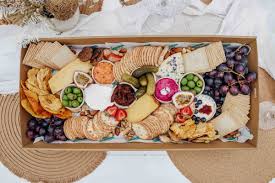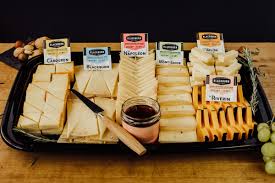Contents
ToggleCheese platters are more than just a dish; they are a culinary masterpiece, a social centerpiece, and a sensory delight. Whether it’s for an elegant dinner party, a casual gathering, or simply a night in with loved ones, a cheese platter can elevate the dining experience to new heights. Let’s delve into the essentials of creating a cheese platter that is both visually stunning and irresistibly delicious.
Understanding the Basics of a Cheese Platter

A cheese platter is a curated selection of cheeses, often complemented by accompaniments such as fruits, nuts, crackers, and spreads. The goal is to provide a balance of flavors, textures, and visual appeal. While it may seem simple, creating a truly exceptional cheese platter requires careful thought and planning.
The key to a successful cheese platter lies in variety. This includes not only the types of cheese but also the accompaniments that will enhance the tasting experience. Each component should work harmoniously to create a balanced and enjoyable experience for anyone indulging in it.
Selecting the Right Cheeses
Choosing the right cheeses is the cornerstone of a remarkable cheese platter. Aim for a diverse selection that includes different textures, flavors, and milk types. Here are a few categories to consider:
- Soft Cheeses: Brie, Camembert, or goat cheese provide a creamy and rich texture that contrasts beautifully with other types of cheese.
- Semi-Hard Cheeses: Cheeses like Gouda, Havarti, or Gruyère add a firmer texture and a nutty or slightly tangy flavor.
- Hard Cheeses: Aged Cheddar, Parmesan, or Manchego bring sharpness and complexity to the platter.
- Blue Cheeses: Roquefort, Gorgonzola, or Stilton offer a bold and tangy flavor profile for adventurous palates.
- Fresh Cheeses: Ricotta, feta, or burrata can provide a light and refreshing option.
When selecting cheeses, consider including a mix of cow’s milk, goat’s milk, and sheep’s milk varieties to add even more diversity to the platter.
Pairing Cheeses with Accompaniments
The accompaniments you choose for your cheese platter are just as important as the cheese itself. These items not only complement the flavors of the cheese but also add texture, color, and variety.
- Fruits: Fresh fruits like grapes, figs, apples, and pears are classic choices. Dried fruits such as apricots, cranberries, or dates also pair wonderfully with cheese, offering a chewy sweetness.
- Nuts: Almonds, walnuts, and pecans provide a satisfying crunch and a slightly savory contrast to the creaminess of the cheese.
- Crackers and Bread: Include an assortment of crackers and breads, such as baguette slices, breadsticks, and seeded crackers. These serve as the perfect vessel for enjoying the cheese and its accompaniments.
- Spreads and Preserves: Honey, fruit jams, chutneys, or mustard can enhance the flavors of the cheese and add a touch of sweetness or tanginess.
- Pickles and Olives: For a briny and tangy element, consider adding pickles, olives, or cornichons.
Balancing Flavors and Textures

A well-balanced cheese platter should offer a variety of flavors and textures. Aim to include cheeses that range from mild to strong in flavor, and from creamy to crumbly in texture. Similarly, the accompaniments should provide a mix of sweet, savory, and tangy options to create a dynamic tasting experience.
The arrangement of the platter plays a significant role in achieving balance. Place bold-flavored cheeses, such as blue cheese, away from milder options to prevent their flavors from overwhelming one another. Arrange accompaniments strategically to encourage a natural progression of flavors as guests sample the platter.
Perfecting the Presentation
The visual appeal of a cheese platter is almost as important as its taste. A beautifully arranged platter can make a striking centerpiece and enhance the overall experience.
- Layering and Arrangement: Start by placing the cheeses on the board, leaving enough space between each piece for accompaniments. Arrange the accompaniments around the cheese in clusters, ensuring a visually pleasing mix of colors and textures.
- Cutting and Serving: Pre-cut hard cheeses into bite-sized pieces or thin slices for easy serving. For soft cheeses, provide a cheese knife for guests to help themselves.
- Decorative Elements: Fresh herbs, edible flowers, or small bowls for spreads can add a touch of elegance and complete the look of the platter.
Catering to Dietary Preferences
It’s important to consider dietary restrictions or preferences mancingduit when preparing a cheese platter. Offer gluten-free crackers for guests who are gluten intolerant, and include at least one dairy-free option if there are vegan guests. Labeling each cheese and accompaniment can also help guests navigate the platter and choose items that suit their tastes.
Seasonal Inspirations for Cheese Platters
Tailoring your cheese platter to the season can add an extra layer of creativity and relevance. For a summer platter, include vibrant berries, tropical fruits, and lighter cheeses. In autumn, opt for earthy accompaniments like roasted nuts, dried figs, and hearty cheeses like aged Gouda. Winter platters can feature indulgent options like triple-cream Brie, spiced nuts, and rich preserves, while spring platters might highlight fresh cheeses and herbs.
Serving and Storing Tips
Cheese is best served at room temperature to allow its flavors and textures to shine. Remove the cheeses from the refrigerator about 30 minutes to an hour before serving. However, be mindful not to leave them out for too long, as some cheeses can spoil or dry out.
If you have leftovers, store each cheese separately in wax paper or parchment paper to maintain its freshness. Avoid wrapping cheese in plastic, as it can trap moisture and cause spoilage.
Enhancing the Experience with Beverages

Pairing beverages with your cheese platter can elevate the tasting experience even further. Wine is a classic choice, with red wines complementing bold cheeses and white wines pairing well with milder options. For beer enthusiasts, consider offering craft beers that match the intensity of the cheeses. Non-alcoholic options, such as sparkling water or fruit juices, can also provide refreshing pairings.
The Social Aspect of a Cheese Platter
Beyond its culinary appeal, a cheese platter fosters a sense of togetherness. It encourages guests to interact, share, and explore flavors together. The casual yet sophisticated nature of a cheese platter makes it an ideal choice for any social gathering, allowing guests to graze at their leisure and spark conversations around the table.
Embracing Creativity in Cheese Platters
One of the most enjoyable aspects of creating a cheese platter is the opportunity for creativity. Experiment with unique combinations, explore cheeses from different regions, or add unexpected elements like chocolate or candied ginger. Every platter you create can be a reflection of your personal taste and style.
The Enduring Charm of Cheese Platters
Cheese platters have stood the test of time as a beloved culinary tradition. Their versatility, elegance, and ability to bring people together make them a timeless choice for any occasion. By understanding the essentials and embracing your creativity, you can craft a cheese platter that leaves a lasting impression on your guests.
Enjoy the process, savor the flavors, and share the joy of a well-curated cheese platter with those around you. It’s not just a dish—it’s an experience to be remembered and cherished.



